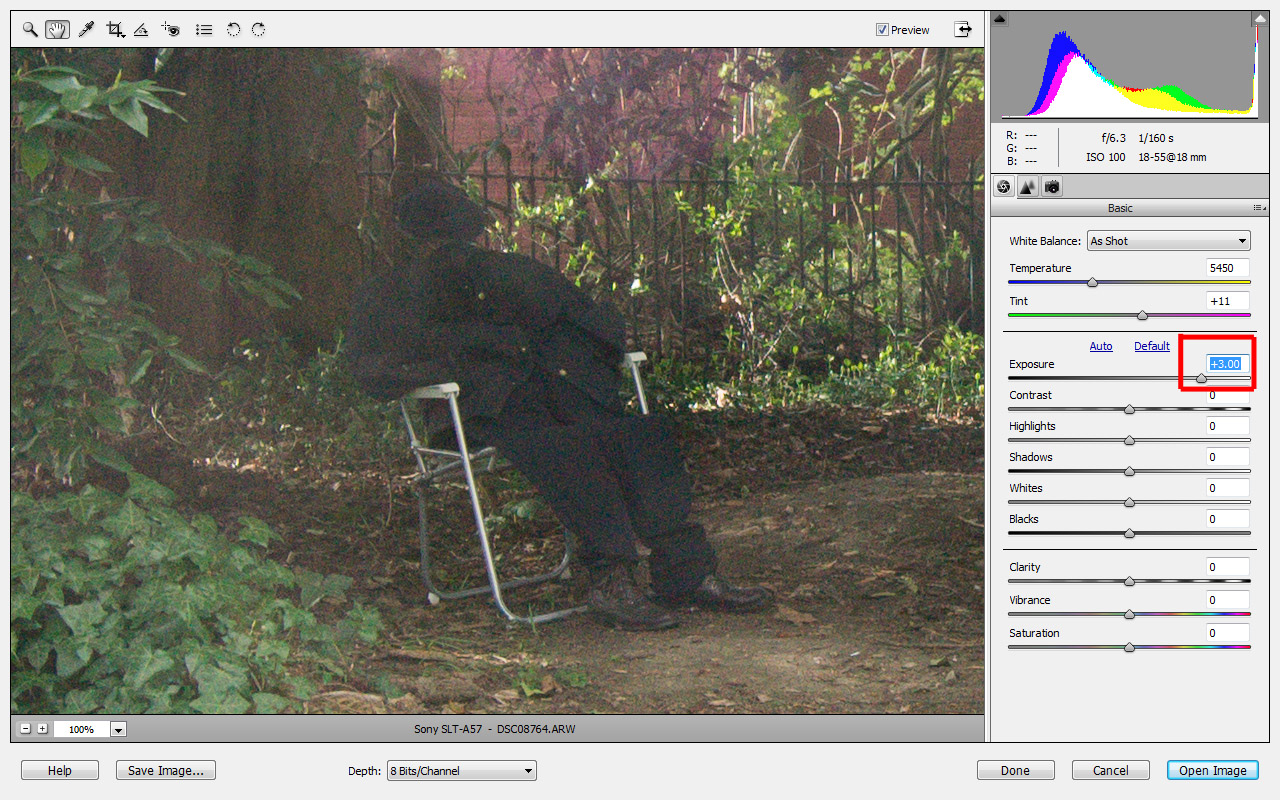 |
| Photograph 1 - an example of highlight clipping (in the waves) |
Firstly, I would admit I had not really noticed the detrimental impact of highlight clipping (the lack of 'roll-off' particularly) in my digital photographs before setting about the highlight clipping exercise. This might have been because I usually shot in the raw camera format and then used the 'recovery' slider or, more recently, the newly introduced 'whites' and 'highlights' sliders to compensate for this within Adobe Camera Raw. Or, it could simply have been because I didn't look closely enough at my photographs (including printing, which was a trait I intended to change).
 |
| Photograph 2 - a high contrast scene |
As soon I began looking for highlight clipping within high contrast scenes it became obvious that there wasn't a very smooth 'roll-off' in such scenes. For example, in Photograph 1 of a man and his dog by the beach, at first glance the whites of the sun catching parts of the sea were quite stark. By zooming in to 100% in this jpeg (Figure 1), I could see the whites were indeed completely white with no film-like 'roll-off'.
 |
| Figure 1 |
I found a setting with high-contrast elements to go about experimenting more critically. I decided to include a highly reflective surface: in this case a lake: to easily produce 'difficult' lighting for my camera to try to handle. Not only was the lake included but I also waited for a sunny day to further increase contrast. As could be seen in the overall photograph (Photograph 2), a lot of the foreground was either in deep shadow or shadow. The lake and the clouds in the sky especially however, were very bright. In the clouds there was some highlight clipping, which was marginal. I had purposefully included this as the course suggested. I used the histogram and the highlight clipping warning in the camera to find a camera setting (in manual mode) where there was just a bit of highlight clipping. Then I adjusted the aperture in one stop increments to create 5 different exposures varying in brightness and importantly 5 different levels of highlight clipping.
I compared these 5 different exposures side to side in Photoshop, zoomed in to the clouds to better observe the differences in highlight clipping at the brightest part of the image (as can be seen in Figure 1 - brightest to darkest exposure from top to bottom). The first exposure crop showed extreme attributes of lost visual information in the clouds. This attribute decreased steadily as the exposures darkened. I would deem the third, 1 stop darker exposure, as adequate in terms of the retention of highlight detail, with the fourth exposure being a bit too dark for my tastes.
 |
| Figure 2 |
I couldn't find any visible breaks in whites in any of the exposures when looking at the clouds but on closer inspection of the lake (the other highltight area) I observed such a break. The break was (unsuprisingly) in the first, brightest exposure and it occurred on and around the swan. While still quite minimal, the effect of the break was there, with no roll-off between the swan and its reflection and the lake as can be seen in the 100% crop in Figure 2.
 |
| Figure 3 |
Again, the next trait I was looking for, wasn't clearly evident but the fringe between the clipped highlights of the clouds and the darker leaves above (in the foreground) did indeed show a colour cast. This only occurred in the first two exposures (the two that possessed highlight clipping) and was not very strong. However, it was still there as can be seen in Figure 3.
I didn't have to look closely to see the lack of saturation in the clouds though. For me it was very obvious in the first two brightest exposures and even in a lesser extent in the third exposure. The clouds had lost the blue-grey tint present in the fourth and fifth exposures and appeared more washed-out (as seen in Figure 1).
I shot in the camera's raw format so using the 'highlights' and 'whites' sliders within Adobe Camera Raw (the new replacement sliders for the single 'recovery' slider used in previous versions of Adobe Camera Raw), I adjusted these sliders to achieve what I felt was the most suitable compromise. The compromise I made was to balance the lack of detail in washed-out highligths and the 'strange, unrealistic effects' mentioned in the course.
 |
| Figure 4 |
When I started experimenting with these two sliders I was first of all taken aback by how effective these sliders seemed to be at bringing back detail. At the end of experimenting I was still impressed but had also learnt an issue I could be aware of in future usage of the sliders. The issue revolved around the detailed parts of the photo, such as the subject's face in the photograph. The more I brought the sliders to the left, the less I found the image's rendition of the face to be realistic. By realistic I am referring to the slightly muted colours of the subject's face in the middle image of Figure 4. Figure 4 (top to bottom) showed the difference between the default setting, an extreme attempt to reduce highlight clipping drastically and a compromise between highlight clipping and realistic facial features (all created from the second brightest exposure raw file).
Overall I came away from this exercise with the insight that as long as you were cautious in not using the relevant sliders for highlight clipping too aggressively, they were extremely useful tools. This was because without much penalty on image quality they effectively brought out the detail in the clouds.




















